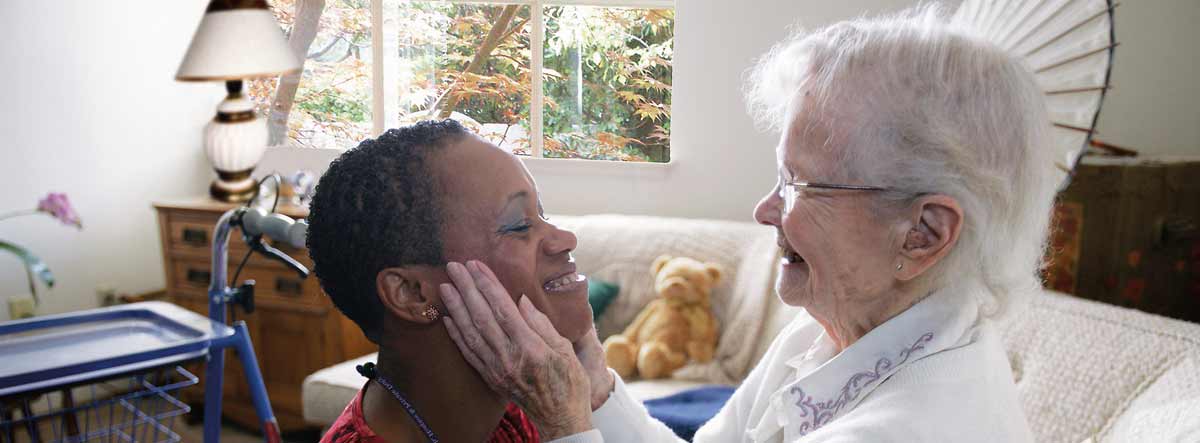
Treating Glaucoma During Hospice Care
January is National Glaucoma Awareness Month, and we thought it would be a good idea to spread the word about this sight-robbing disease. According to the Glaucoma Research Foundation, more than three million people in this country suffer from glaucoma (mostly older adults and elderly), with projections reaching 4.2 million by 2030. Even though it’s the leading cause of irreversible blindness, many people (about half) don’t even know they have it. If you have a loved one in hospice care in San Francisco and elsewhere and they have glaucoma, it’s still important to treat this disease as it progresses, at least for comfort purposes.
What is Glaucoma?
First, a little bit about glaucoma. It’s referred to as “the sneak thief of sight” because there are no initial symptoms; worse yet, once vision has been lost, it’s lost forever. In fact, up to 40 percent of your vision can be lost without you even noticing. This is why regular screenings and checkups are important as we age.
When combined with our aging population, there is an epidemic of blindness coming if more awareness is not raised about the importance of regular eye exams to preserve eye health. The World Health Organization says 4.5 million people around the world are blind due to glaucoma. This is a condition that damages the eye’s optic nerve, worsening over time. It’s linked to a pressure buildup inside the eye, but you usually don’t get this till later in life.
The increased pressure in the eye is known as intraocular pressure, and it can severely damage the optic nerve, which is responsible for sending images to the brain, says WebMD. As that damage worsens, glaucoma can quickly progress to permanent loss of vision or even total blindness within just a span of a few years.
Trick is, most people have no early symptoms or pain associated with their glaucoma, which is why it’s critical for people to visit their eye doctor regularly so it can be diagnosed and treated before long-term vision loss has a chance to occur. Once vision is lost, it can’t be restored; however, if eye pressure is lowered, the sight you still have can be preserved.
Support Vital for Hospice Patients With Glaucoma
Many people who enroll in hospice already have severe vision loss due to glaucoma. After the person’s ophthalmologist has eliminated all the factors that might contribute to progression, they must start thinking about palliative care to maintain comfort, points out Ophthalmology Times. Once the patient has lost all vision, pressure must be kept low enough to prevent pain. Pain doesn’t just stem from the pressure itself; corneal bullae (small vessels in the cornea) may form and then rupture, causing excruciating pain as well. Medication can be used to control pain.
It’s important to note that even when physicians cannot slow the process towards blindness in a hospice patient, they should always offer comfort and sympathy for the condition. There are many resources available to the patient to help them manage pain and also handle the effects of the blindness itself, acknowledging their feelings of helplessness, isolation, and loss of independence. It’s also important to remain sensitive to cultural differences and the perceptions that blindness carries for each individual, always on the alert for signs that the patient has become depressed.
Switching Gears
In hospice, the goal switches gears from aggressive treatment courses to preserve vision to a focus on maximizing quality of life for the patient. The care team should be able to identify and be more comfortable with patients with glaucoma at the end of life. Even families have to adjust, even though it may be uncomfortable. Often times, elderly patients have seen their eye doctor for many years to manage their glaucoma, consequently developing a high level of trust.
Patients and their caregivers may be so used to the administration of daily drops and other medications to try and reverse the disease that it can be disquieting to take on more of a pain control and management role going forward. Goals must be reassessed for glaucoma patients in hospice, including having a discussion about how the use of treatment influences their lives, such as administering the drops to the eyes as well as the possible side effects. The care team must re-evaluate the need for each medicine and determine if the additional drops are worth it to the patient at this stage.
Prescription drugs must also be re-evaluated as many can cause distressing symptoms at the end of life, such as pain, nausea, anxiety, and constipation. Drugs used to treat the condition in hospice are often discontinued due to the adverse symptoms they cause, which are considered more distressing than the initial problem (in this case, glaucoma). The focus of care then shifts to palliation and comfort measures.
Contact Pathways Home Health and Hospice
To learn more about our hospice services and how we can maintain comfort for your loved one with glaucoma, contact us at 888-978-1306.

